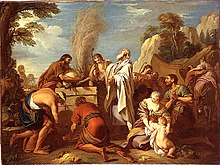Charles-Joseph Natoire
Charles-Joseph Natoire | |
|---|---|
 Natoire byGustaf Lundberg | |
| Born | 3 March 1700 |
| Died | 23 August 1777(aged 77) |
Charles-Joseph Natoire(3 March 1700 – 23 August 1777) was a French painter in theRococomanner, a pupil ofFrançois Lemoyneand director of theFrench Academy in Rome,1751–1775. Considered during his lifetime the equal ofFrançois Boucher,he played a prominent role in the artistic life of France.
He is remembered above all for the series of theHistory of PsycheforGermain Boffrand's ovalsalon de la Princessein theHôtel de Soubise,Paris,and for the tapestry cartoons for the series of theHistory of Don Quixote,woven at theBeauvais tapestrymanufacture, most of which are present at theChâteau de Compiègne.
First Roman stay (1723–1729)[edit]
He was born inNîmes.His sister,Jeanne,was apastellist.[1]
Natoire's father Florent Natoire, a sculptor, gave him his fundamental training in drawing, then sent him to Paris in 1717 to complete his training, first in the atelier ofLouis Galloche(1670–1761),peintre du Roiand professor at theAcadémie royale de peinture et de sculpture,and then in the atelier ofFrançois Lemoyne,whose training shaped Natoire's style.[2]Later, as a history painter, Natoire would instruct students at the Royal Academy.[3]

In 1721, he was awarded thePrix de Romefrom the French Académie Royale with aSacrifice ofManoahto obtain a son.[4]On 30 June 1723 he was appointed apensionnaireat theFrench Academy in Rome,at the time lodged in thePalazzo Mancini,where he arrived in October. During his stay he executed a copy ofPietro da Cortona'sRape of the Sabine Women.In December 1725, he won a first prize from theAccademia di San Lucawith aMoses Returning from Sinai.[5]In 1728, he painted for the French ambassador, theprince de Polignac,anExpulsion of the Money-Changers from the Temple.
In Paris (1730–1751)[edit]
Natoire returned to Paris viaVenicein the early part of 1729. He was received into the Académie royale de peinture et de sculpture on 30 September 1730.
His reputation was quickly established, and he received major commissions notably from French QueenMarie Leszczyńskato paint several of her children. From 1731 to 1740 he provided several suites of canvasses forPhilibert Orry,contrôleur général des finances,who was to succeed the duc d'Antin as general director of theBâtiments du Roiin 1736. For Orry's Château de La Chapelle-Godefroy atSaint-Aubin, AubeNatoire provided a series of nine canvasses ofHistories of the Gods,six more of theHistory of Clovis,six of aHistory of Telemachusand four Seasons. During the same period, in 1732 he provided threeoverdoorson Old Testament subjects for the duc d'Antin in Paris.

In June 1734, Natoire submitted to an Exposition de la Jeunesse in place Dauphine aGalatea.In the same year his first royal commission arrived, for the Chambre de la Reine atVersaillesand was made a full member of the Académie on 31 December with aVenusCommanding fromVulcanthe Arms ofAeneas.[5]Henceforth, numerous royal commissions came his way for the petits appartements at theChâteau de Fontainebleau,for the Cabinet du Roi and the royal dining-room at Versailles, decorations forMarly,for theCabinet des Médaillesin the royal library in Paris, and others.
In 1735, Natoire carried out the first of his tapestry cartoons for the seriesHistoire de Don Quichottewoven at the Manufacture de Beauvais, the first set for thefermier généralPierre Grimod du Fort(1692–1748). In 1737 he received the commission for theHôtel de Soubise.[6]From 1741, he produced a series of cartoons for theHistory ofMark Anthonywoven at theGobelins.
In 1747, he painted the portrait ofLouis, Dauphin of France.In a more familiar vein, he provided aSaint Stephen and the False Witnessesfor the chapelle Saint-Symphorien in theChurch of Saint-Germain-des-Prés,1745. A major loss was his illusionistic decor for the chapel in the Hôpital des Enfants-Trouvés (1746–1750), built by Germain Boffrand but demolished in the 19th century.[4]Also in 1747 he participated in the competition organized by the new general director of the Bâtiments du Roi,Le Normant de Tournehem,with theTriumph of Bacchus,now in theMusée du Louvre.
Second Roman stay (1751–1777)[edit]
In 1751, Natoire was appointed director of the French Academy in Rome, a prestigious position, but one that was to set a seal on his active career. Far from court, Natoire witnessed his rivalsCarle Van Loo,thenFrançois Bouchernamedpremier peintre du Roiin turn. He all but ceased painting, turning his energies instead to the Academy, pressing thepensionnairesto produce theenvoiesthat were forwarded to Paris as proof of their progress and sending them out to draw in the countryside of the Roman campagna. Among his students wereHubert RobertandJean-Honore Fragonard.[5]

He was ennobled in April 1753 and received theOrder of Saint-Michel,an honour he had impatiently awaited, but he found himself out of sympathy with the newneoclassical stylethat was being developed by the Academy's pensionnaires. His own fresco of theApotheosis of Saint Louisfor the French national Church ofSan Luigi dei Francesi,1754–1756, came in for criticism.
Natoire's late work, in the two decades that remained to him was largely confined to numerous drawings of the Campagna for his own pleasure, and few canvasses. He became more religious.
In 1767, the architect Adrien Mouton, who had been expelled from the Academy, brought a suit that he won in 1770: Natoire was fined 20,000 livres and court costs with interest, accused of administrative errors. The new general director of the Bâtiments, thecomte d'Angivillerretired Natoire from office in June 1775.
He withdrew toCastel Gandolfo,where he died.
Gallery of selected work[edit]
-
Sibylle
-
Portrait of French bishop and theologian Jean-Joseph Languet de Gergy.
-
Psyche and Proserpina.
-
Young women with roses.
-
The Rebuke of Adam and Eve (1740)
-
The Triumph of Bacchus
References[edit]
- ^Profile of Jeanne Natoirein theDictionary of Pastellists Before 1800.
- ^"Charles Joseph Natoire:The Rebuke of Adam and Eve", The Metropolitan Museum of Art
- ^"Charles-Joseph Natoire", The Frick Collection
- ^ab"Charles-Joseph Natoire (1700-1777)", The Royal Collection Trust
- ^abc"Charles-Joseph Natoire", Getty Museum Collection
- ^Bailey, Gauvin Alexander (2014).The Spiritual Rococo: Decor and Divinity from the Salons of Paris to the Missions of Patagonia.Taylor & Francis(1st ed.).Routledge.ISBN978-1409400639.
- This article depends in large part on a translation from French Wikipedia, where a list of Natoire's paintings may be found.






